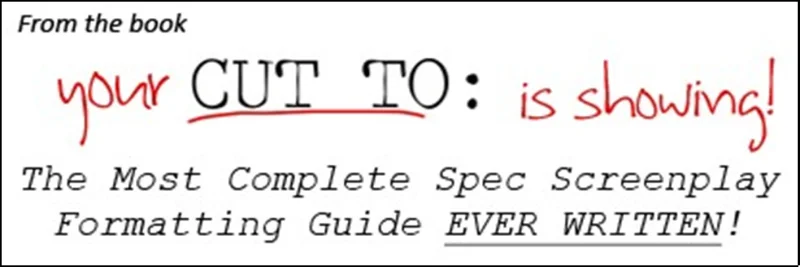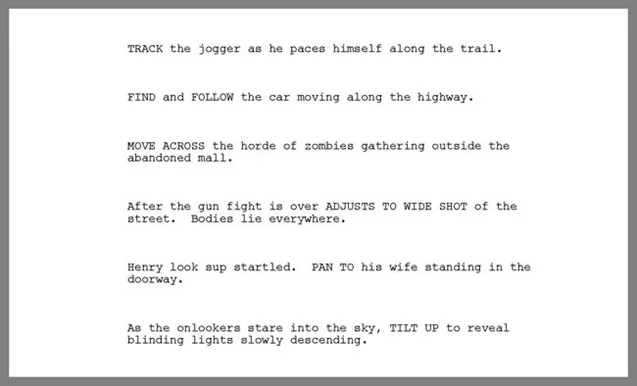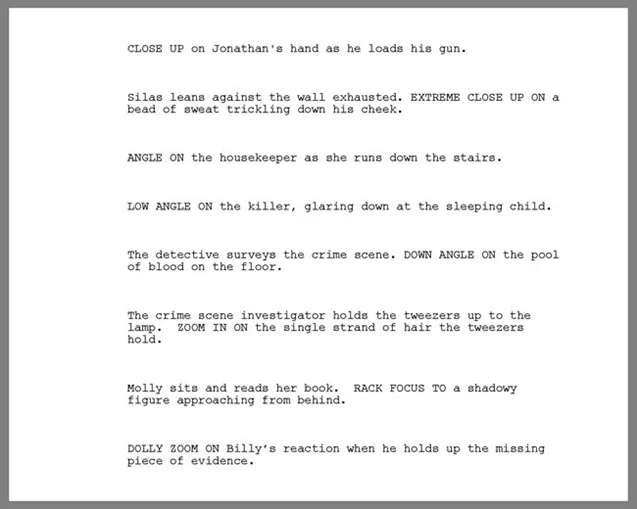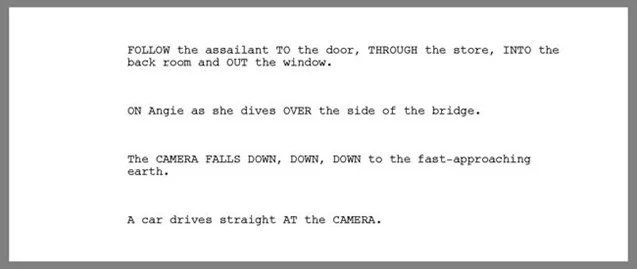
Screenwriting ABCs Script Formatting
Capitalization: Camera Direction
by T. J. Alex
Book Excerpt, 4 pages
Viewed by: 42 Residents and 1442 Guests

Capitalization: Camera Direction
WARNING: THE INFORMATION IN THIS CHAPTER SHOULD BE USED SPARINGLY, IF AT ALL!! THE BEST SCREENWRITERS CAN WRITE AN ENTIRE SCREENPLAY WITHOUT WRITING A SINGLE CAMERA DIRECTION!!
Basic Camera Movement:
The first thing a writer should know when it comes to Capitalization of Camera Direction is that the word CAMERA will always be Capitalized, unless, of course, the word "camera" refers to an actual camera on screen being used as a film prop.

Here are some examples of how Camera Direction is used in Direction:

TRACKS and FOLLOWS function the same way and lets the reader know the camera moves in conjunction with the subject of shot throughout the scene. If a writer MUST call out camera direction, I personally prefer to see trackings as a TRACKING SHOT in the Scene Heading.
PAN means the camera moves from one subject to the next without cutting from one to the other, but rather "sliding" over with no loss of time. They are also used for shots of surrounding scenery.
You could just as easily write the same Direction without the word CAMERA to make it seem less like you are giving Camera Direction, but don't lie to yourself. You are not fooling anybody. Here is how they could read:

Close Ups, Angles, and Zooms:
Sometimes you can call out Camera Movement by cueing Close Ups and Camera Angles. Other times you may not want to change the camera placement, but you'll want to change the camera's zoom or focus. Here are some examples:

LOW ANGLE means that the camera is set up low and aimed high. HIGH ANGLE has the camera up high and facing down towards a subject.
DOWN ANGLE and UP ANGLE do the same things, but in opposite ways. With a DOWN ANGLE the camera is up high facing downward, while the UP ANGLE is the other way around.
These are used often to show dominance or weakness, but sometimes just provide a POV-type shot.
RACK FOCUS is the type of focus you often see in films where the foreground is in focus while the background is out of focus (or vice-versa), but then the focus changes from foreground to background to highlight something for the audience that characters on screen might not be privy to.
DOLLY ZOOM is often called the "Hitchcock Zoom" or the "Vertigo Zoom" because of its most famous use in that film. This is a zoom used to show a character's realization of something significant, a sudden flash of clarity, if you will. Spielberg also famously used it in Jaws. The effect has the background changing perspective while the subject in the foreground stays the same in spite of the camera being pulled away. The effect is a distortion that can have an unsettling effect on the audience. Brilliant.
RACK FOCUS and DOLLY ZOOM are two of the VERY few Camera Directions I can stomach.
Prepositions:
Sometimes writers will use Prepositions (such as IN, ON, OVER, UNDER, WITH, TO, AT, INTO, THROUGH, etc.) as a less-intrusive means to cue Camera Direction. In such situations, the Prepositions get the ALL CAPS treatment. Here is how they might look on the page:

Into Frame and Out of Frame:
Sometimes writers will announce when a character comes INTO FRAME or goes OUT OF FRAME, meaning that he/she walks into the view of the camera or out of the view of the camera.
Here is how that might look:

The terms INTO VIEW and OUT OF VIEW may also be used interchangeably with INTO FRAME and OUT OF FRAME, as they mean the same thing.
Of course, there may be a situation in which a character is hiding behind an object or person on screen, making him/her technically "in frame" while at the same time "out of view" of the camera. If the character were to then jump out of hiding and come "into view", the writer needs to type into view in lowercase. Here is one such situation:

In the example above, the body guard was already "in frame" and Mondell was hiding "out of view" behind him.
Second Person:
Still other writers (very annoyingly, I might add) will write Camera Direction in the Second Person. There are some examples below, but I warn you - DO NOT DO THIS! It is unprofessional and makes for a terrible read.

If you DO decide to risk having your script tossed in the trash quickly by writing Camera Directions using the Second Person, at least do it correctly. Note that the pronouns "we" and "us" are always written in lowercase with the Camera Direction in ALL CAPS.
------------------------------------
For more screenplay formatting rules and advice, check out the book, Your CUT TO: Is Showing! by T. J. Alex or visit www.scripttoolbox.com. From there, please like the page on Facebook, and share it with your friends.
If you have any formatting questions, please email T. J. at tj@tjalex.com.




